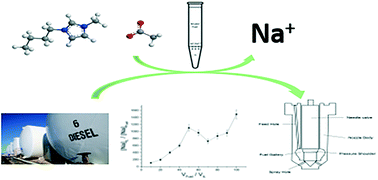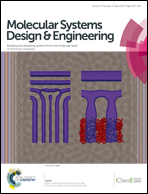Use of ionic liquids to minimize sodium induced internal diesel injector deposits (IDIDs)†
Abstract
Trace amounts of dissolved sodium has been identified as one possible cause leading to the formation of internal diesel injector deposits (IDIDs) which prove problematic by reducing fuel efficiency in high pressure diesel injectors. We demonstrate the successful extraction of ppm levels of Na+ from a model diesel fuel. A range of ionic liquids (ILs) with a variety of cations and anions were examined for their effectiveness at different loadings of IL relative to the model diesel fuel. Results provide several clear trends with some exceptional capabilities of the ILs in the extractions. ILs are commonly referred to as ‘designer solvents’, due to the great degree of fine-tuning of physical and chemical properties afforded by modification of the constituent cation and anion. The tunable properties of the ILs ions allow the ‘design’ to meet the requirements for a particular target and here provide several potential candidates for the extraction of the ppm levels of sodium from diesel fuel. We report for the first time that ILs can extract up to 99.1% of Na+ from a model diesel fuel at a Na+ concentration of just 3 mg kg−1 in the fuel; factors affecting the extent of extraction were investigated via correlation with experimental solvent descriptors. 23Na NMR was used in the determination of donor number (DN), and Kamlet–Taft parameters were gathered for each IL providing information of possible hydrogen-bond acidity/basicity (α/β) and dipolarity/polarizability solvent strength (π*). In addition, the non-random two liquid model (NRTL) was applied to correlate the experimental extraction results and determine τ parameters for each of the ILs. We determined that the extraction is controlled strongly by the Lewis basicity of the IL which is directly related to the ability of the anion of the IL to complex Na+ and thereby remove it from the fuel. DN, τ parameters and β, in addition to interfacial tension and viscosity values, provide further information on the extraction mechanisms and predict performance, enabling chemical design of ILs that are ideal for fuel purification.



 Please wait while we load your content...
Please wait while we load your content...